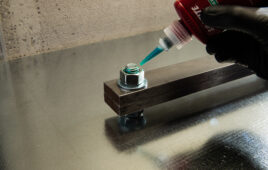
Silicone sealants are often used to seal windows to frames, providing a water-resistant seal that withstands harsh weather conditions. For this
reason, it’s also commonly used for automobiles, appliances, and sealing cables and sensors in electronic devices.
Silicones are reactive adhesives that are part organic, part inorganic. They’re fully synthetic materials, unlike anything found in nature. A unique structure gives them unique properties.
Silicones are polymers of polydimethylsiloxane, with the occasional methyl replaced with another organic side chain. What remains constant is the backbone of silicone atoms linked via single bonds to oxygen. Silicon wants four bonds. The two not bonded to oxygens join with methyls or other organic side chains.
Altering a few of the organic side chains facilitates the crosslinking necessary to make silicone adhesives. It makes the silicones reactive.
The properties of silicone resins are unlike other materials. They exhibit excellent thermal stability, working well at temperatures as low as -80° C (-112° F) and up to 250° C (482° F). They’re fire-resistant and generally withstand aging from environmental exposure due to oxidation and UV light. As an adhesive, silicone resins bond with several substances and remain flexible over a wide temperature range. Several different cure chemistries can be employed.
Most will be familiar with the distinctive acetic acid or vinegar smell characteristic of some silicone sealants. These silicones are one-part adhesives, reacting with atmospheric water during cure. Acetoxy groups at the ends of polydimethylsiloxane chains liberate acetic acid when reacted with water and in the presence of a catalyst, generally a tin compound. The resulting -OH capped silicon reacts with other acetoxy substituents, liberating more acetic acid as the resin cures.
As useful as these adhesives and sealants are, some applications are incompatible with the release of acetic acid. Fortunately, there are a variety of cure chemistries. Platinum-catalyzed curing of vinyl siloxanes is typically initiated by heat. Nothing is released when these cure, so there’s no concern for smell or reactivity. Two-part chemistries are also available.
Irrespective of the cure chemistry, the resulting cured resins are quite similar. The bond formed is flexible and resists conditions that many other adhesives cannot handle.
 Most silicone adhesives are sticky. Prior to cure, they adhere well and coat many substrates, and joints can be repositioned until the resin sets. The cure time last seconds to days, varying widely with the cure chemistry. Many silicones do not attain full strength until after 24 hours.
Most silicone adhesives are sticky. Prior to cure, they adhere well and coat many substrates, and joints can be repositioned until the resin sets. The cure time last seconds to days, varying widely with the cure chemistry. Many silicones do not attain full strength until after 24 hours.
In general, silicones are safe but pose some risks. For example, exposure to silicone can cause allergic reactions in some. Skin and eye irritation are also possible because of the release of compounds like acetic acid during curing. Follow the directions when using silicone adhesives, use appropriate personal protective equipment, and work in well-ventilated areas. Cured silicones typically present no health risk.
Cured silicone resins tend to be rubbery materials. But strong, resilient bonds can be made to various substrates.
Whether a one or two-part formulation, cured silicone does not dissolve easily in any solvent, regardless of the cure chemistry. Organic solvents can frequently be used with uncured adhesive. Cured resin is generally soft and can be removed mechanically from most surfaces. Solvents are available commercially that will soften cured resins to aid in removal.
Silicone adhesives are the choice when environmental conditions eliminate other options. They offer many advantages in suitable applications.









Tell Us What You Think!